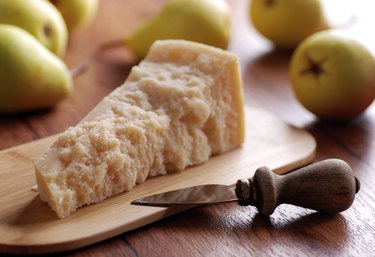
Cheese-making can be a very simple or an infinitely complex process, depending on your level of ambition. Fresh cheeses, such as cottage cheese and Indian panir, are quick and easy to produce. Complex, long-aged cheeses such as Parmesan-style hard cheeses require skill, specialized equipment and lots of patience. If you're experienced in basic cheese-making and want to take that next step into more challenging varieties, a hard Parmesan-style cheese is a worthy adventure.
It's Not Parmesan
Video of the Day
The first thing to understand is that however fantastic your cheese turns out, it's not Parmesan. True Parmesan cheese, or Parmigiano-Reggiano to give it its proper name, hails from the region around the Italian city of Parma. Only cheeses from that specific geographic area, made from unusually fresh milk in a specified, centuries-old method, can legitimately be called Parmesan in most of the world. The U.S. is a notable exception, permitting many lesser products to bear that lofty name.
Video of the Day
Getting Started
Real Parmesan cheese uses milk collected and skimmed in the evening, mixed with an equal quantity of full-fat milk from the next morning. That's difficult to do unless you own your own cow, but if you have access to an artisanal dairy that sells non-homogenized milk, that's a start. Skim the cream from half of your milk, then combine it with the other half. Batch sizes from 2 to 7 gallons are usually practical for home hobbyists. Heat the milk gently in a water bath to a temperature of 90 to 93 degrees Fahrenheit, than add a bacterial culture or plain yogurt to lend complexity to its flavor. After 30 minutes at that temperature, you'll add your rennet.
Curds and Whey
It takes several minutes for the rennet to visibly curdle your milk, and about 15 minutes in total. Then you'll cut the curd, first into squares with a knife and then into cottage cheese-sized pieces with a restaurant-sized metal whisk. Increase the heat slowly for about 20 minutes, until your curds reach a temperature of about 130 F. They'll shrink as they heat, becoming grain-sized. Pour the curds into a cloth-lined colander, reserving the hot whey and pouring it back into the pot. Tie up your cloth bag of curds and dangle it from a sturdy dowel, so it hangs down into the whey.
Shaping and Draining
You'll hang your curds in their bag for an hour, lifting them out five or six times and rolling the bag of curds on your counter to shape it. At the end of the hour, transfer your curds to a sterilized mold in your cheese press. The massive wheels of commercial Parmesan press themselves, but smaller home-sized batches need some help. Start by setting your cheese press for just 10 to 15 pounds of pressure, until a thin trickle of whey runs from the mass of curds. Increase the pressure as needed whenever the whey slows, until you reach about 25 pounds of pressure. Drain the cheese overnight at that setting.
Brining and Aging
Remove the cheese from its press and let it rest at room temperature for a couple of days, to give its bacterial culture a good head start. Then soak the cheese in brine, allowing about six and a half hours for every pound of cheese or every gallon of milk you'd used. The two measures are roughly equal. Finally, remove your cheese from the brine, dry it, and wipe it with a light coating of oil. Age it for at least eight to nine months, or up to two years if you have the patience, in a cool, well-ventilated location. Turn it regularly, re-oiling the surface daily and wiping away mold if it appears.